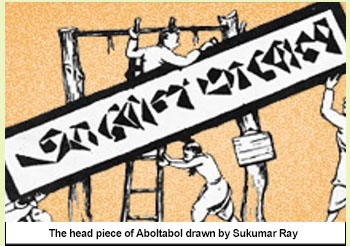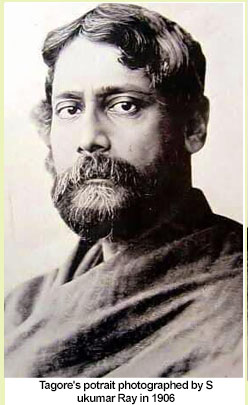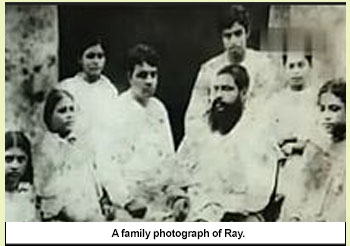The Rays' cinematic reunion: A glimpse into Sukumar Ray's world
The Statesman dated 29th September 2023
 In the year 1961, a significant tribute was paid by the renowned filmmaker and author Satyajit Ray.He chose to resurrect Sandesh, the beloved children's magazine originally established by his grandfather, Upendrakishore Ray Chowdhury. This heartfelt endeavour was not only an homage to his grandfather's legacy but also a poignant acknowledgment of the immense contribution made by his father, Sukumar Ray. Under Sukumar Ray's remarkable editorial guidance,
"Sandesh" had achieved iconic status,
becoming a household name throughout Bengal.
In the eight years that Sukumar
got to take over the editorship of
Sandesh, he wrote and illustrated
innumerable pieces that are revolutionary in any sub-adult literature in
the world. So Sandesh, the magazine
again relaunched under the editorship
of Satyajit Ray and Subhash
Mukhopadhay in 1961, was actually a
giant step to rediscover the world of
Sukumar Ray, who died in 1923 just at
the age of 35.
In the year 1961, a significant tribute was paid by the renowned filmmaker and author Satyajit Ray.He chose to resurrect Sandesh, the beloved children's magazine originally established by his grandfather, Upendrakishore Ray Chowdhury. This heartfelt endeavour was not only an homage to his grandfather's legacy but also a poignant acknowledgment of the immense contribution made by his father, Sukumar Ray. Under Sukumar Ray's remarkable editorial guidance,
"Sandesh" had achieved iconic status,
becoming a household name throughout Bengal.
In the eight years that Sukumar
got to take over the editorship of
Sandesh, he wrote and illustrated
innumerable pieces that are revolutionary in any sub-adult literature in
the world. So Sandesh, the magazine
again relaunched under the editorship
of Satyajit Ray and Subhash
Mukhopadhay in 1961, was actually a
giant step to rediscover the world of
Sukumar Ray, who died in 1923 just at
the age of 35.
Ray again offered his literary tribute to his illustrated father in 1966
when he translated many poems from
Abol Tabol (The Ridiculous) and the
collection Nonsense Rhymes of Sukumar. Ray opened the door for nonBengali readers to read Sukumar. With
his extraordinary command of both
Bengali and English, Ray did almost
equal justice to the English translation.
His father's extra-ordinary power of
imagination and peerless selection of
words were converted into English
with no loss of magic in most of the
translation.
Ray got the best chance to offer
the richest tribute to his father in his
birth centenary year of 1987 when the
Government of West Bengal offered
him to make a documentary on Sukumar Ray.
Cinema, the most adorable form
of art to Satyajit Ray, was perhaps the
best way to pay homage to his father,
but this time luck was not on Satyajit
Ray's side. It was a time when he was
slowly recovering after a prolonged
period of suffering from heart disease.
He has been partly bedridden and
homebound since 1984. He was not
doing any films or even travelling
unless it was very essential.
Thus, when the offer landed on
his lap, he accepted it, knowing his
limitations as a director.
The biggest challenge of making a
documentary on Sukumar Ray was
that there was no film footage of the
man. For any biographical documentary film, footage of the man in the
subject adds huge visual delight. Ray,
while making a documentary on
Rabindrnath Tagore in 1961, was
blessed with several film clips and
newsreels of Tagore taken both in
India and abroad. This time, deprived
of such elements, he was forced to
depend on old photographs, illustrations, newspaper clips, old family letters, diaries, etc. With this, Ray had to
recreate the magic of his script-writing perfection for documentaries that
the world had seen in Rabindranath
Tagore, Sikkim, Bala and Inner Eye.
The first thing that made it difficult for Ray to make a documentary on
his father was his misfortune of not
knowing him personally as a son. Ray
lost his father in 1923, when he was
just two and a half years old. So many
times Ray has said clearly that he is not
introduced to his father as any son
does, but rather that he knows him
through his world of creativity.

This disadvantage of not knowing a father but only knowing an iconic
literary genius named Sukumar Ray
actually converted into an advantage
to the director because it prevented
him from going overly emotional at
any point in the entire film. Ray, unlike
recreating childhood scenes from the
Rabindranath Tagore documentary,
just used many black-and-white photographs of Sukumar and his family
members at the beginning of the film.
In the first 12 minutes or so, Ray navigates into the world of the Ray Chowdhury family with a lot of known and
unknown facts through the background commentary rendered by
Soumitra Chatterjee. The best part of
that part is telling the rich cricket legacy of his family, a fact not known to
many people before the era of Google.
Sukumar's role and efforts to
make Sandesh a leading children's
magazine of that time are very visible
in the film. Ray salvaged and showed
many rare cover designs, headpieces,
and illustrations done by his father for
Sandesh. In a nutshell, he exploited the
unseen archive of the magazine to a
great extent, which no doubt enriched
the film. It is a visual delight to see the
colour paintings of Sukumar and his
modern printing output on the pages
of his edited magazine.
Ray spent a considerable amount
of time connecting Sukumar's close
relationship with Rabindranath
Tagore. He mentions Sukumar's association and Tagore's affection for this
talented servant of Bengali literature.
In the documentary, we get to see a
group photo taken in London in 1912
where a young Sukumar Ray, then
doing higher studies in printing and
photography in England, is seated next
to Tagore, who was travelling to England with his English translation of
Gitanjali. The film shows Sukumar's
article on Tagore's literary work, which
was published in London's famous
Quest magazine. It talks about the
movement launched by Sukumar and
his young friends of Bramha Samaj to
include Tagore in its committee, and a
small booklet with the title "Keno
Rabindratha ke Chai" (Why
Rabindranath is required), then published by the young gang, was also
shown.

As an editor, Sukumar Ray convinced Tagore to contribute to
Sandesh. A clip comes on the screen
where the spectator sees Tagore's signature on the page of Sandesh.
Tagore's soulful lecture read in Shantiniketan after Sukumar's untimely
demise and Tagore's visit to him on his
deathbed were also mentioned in the
commentary rendered.
Surprisingly, Satyajit Ray omitted
two vital facts that relate to Tagore and
his father.
One is an iconic photograph of
Tagore taken by Sukumar Ray; it was
not mentioned in the film, and another
fact that went unmentioned is Tagore's
special preface written for Sukumar's
first story book, Pagla Dashu, published in 1940, 17 years after his
demise.
Ray tried to include every single
creative merit that Sukumar Ray
showed in his short life as an editor,
illustrator, club secretary, organiser,
photographer and even as an activist
in Brahmo Samaj.
His proficiency in technology,
whether it is modern printing or photography, was vividly mentioned in the
film; however, Ray missed to mention
that Sukumar was a very good organ
player and music composer, as well as
a merit Satyajit
himself
inherited from a man with whom he
did not interact much in real life.
Another vital side of Sukumar Ray,
which his son did not mention in the
documentary, was that he was a science fiction writer and a contributor
of serious articles to leading publications both in English and Bengali.

While in London, Sukumar, an
avid follower of modern printing technology and photography, wrote two
serious articles in Penrose's Pictorial
Annual. He also contributed an article
to Probashi. Recently, an article published in Ananda Bazar Patrika by
Goutam Chakraborty on 24 September
2023, has shown the vast arena of natural science, astronomy, industrialisation, history and civilization to which
Sukumar contributed 105 articles in
his edited magazine Sandesh, along
with at least 16 biographies of titans
like Charles Darwin, Joan of Arc, Livingstone, Florence of Night, etc.
In the 1920s, Sukumar inserted
the idea of sending man to the moon
through a firework rocket in a writeup and also clarified the evolution theory of Charles Darwin for his young
readers. Considering all these extraordinary articles written by a young editor of a magazine, Debasis Mukhopadhay, in an article published in Aajkal
dated 30 October 2022, it is very rightly
said that it was Sukumar Ray who
upgraded the child magazine Sandesh
magazine from a child magazine to a
new age teen magazine when no one
in India ever thought of such an idea.
It is unfortunate that this amazing
side of Sukumar Ray was not boldly
mentioned in the script of Satyajit
Ray's documentary. He had the chance
to throw light on this side of Sukumar
Ray rather than give too much importance to the enactment of his plays.
While trying his best to project
Sukumar Ray as a mature, talented literary figure not confined to
the small world of children's
literature, Satyajit Ray simply
overlooked a wider spectrum of his
father's work.
The documentary is a good example of self-control exercises.
Satyajit had every easy scope to
overload the script with many short
interviews and bytes of elderly people,
including himself, talking about Sukumar Ray, but he did not include any.
His own name comes only once when
commentary runs to describe that in
1921, Sukumar's wife Suprabha gave
birth to a son, and the newborn was
named Satyajit.
It was the point where emotional
turmoil could have overtaken Satyajit
Ray. He could have added information,
like that his name was initially decided
to be Prasad, which was later changed
to Satyajit. He even did not mention the
only recollected memory of him with
his father seeing a steamer going on the
Ganga in Sodepur. All these small titbits, which have huge personal value
but are not that important for common
people, were smartly and ruthlessly
avoided. In this regard, Ray has shown
his global standard as a filmmaker.
To make the audience understand
Sukumar Ray's ability as a playwright,
Ray screened three of his plays in small
fragments. Noted actors like Utpal
Dutta, Soumitra Chatterjee, Chiranjit
Chakraborty, Santosh Dutta, Tapen
Chatterjee and young students of
Patha Bhavan School were cast. While
The character of Santosh Dutta in the
play "Ha Ja Ba Ra La" was shown in
shadows and made a profound impact
in the film. The play "Lakshmaner
Shaktishel" is covered for a longer
span, and Tapen as Hanuman and
Soumitra as Ram enacted the play like
any normal play. A song by Anup
Ghoshal was also included in it.

The best thing about this documentary is that Ray did not try to show
Sukumar Ray as a writer only meant
for children's literature. The entire
effort given by Ray in this film is to
show Sukumar as an exceptionally talented man who is equally comfortable
in the worlds of science, the arts, and
commerce as well.
The documentary ends with the
last stage of Sukumar's life and finally
his premature death when he was at
the apex of his creativity. In his many
poems, Sukumar was slowly expressing his impending death in a pensive
tune, and Ray made Soumitra read one
of his last poems, which talks about
ending his song "Ganer Pala Sango
Mor .
Ray showed clips of many newspapers reporting the untimely death of
Sukumar Ray, and in that, The Statesman was shown with the wrong masthead. As an avid reader of The Statesman from his early teens, this should
not have been overlooked by Ray.
Satyajit Ray scholar Debasis
Mukhopadhay thinks that it will be
unfair to compare Ray's other classical documentaries with this Sukumar
Ray, which he did inside the studio
and even some work at his home.
Debasis, who is one of the best
collectors of anything related to Satyajit Ray, thinks the flashing of various
characters in Sukumar Ray's writing
shown in the beginning of the film
itself is a little amateurish, and Ray's
inability to take a camera outdoors is a
big drawback of the film. Debasis
reminded me that this is the only documentary Satyajit Ray made in which
he himself did not do voiceover commentary in his signature baritone, and
this is his only documentary made in
Bengali. The rest of the four are all in
English, and he himself is the voice
behind the screen.
No master has all his work equally
great. So is Satyajit Ray. Considering
his physical limitations at the time of
making this documentary, the tight
budget provided by the Government
of West Bengal, and the additional
mental pressure of not falling into any
trap of being overly emotional, Satyajit
Ray tried his best in his last documentary that he made after many years.
The Sukumar Ray documentary,
directed by Satyajit Ray, was to be
released on 30 October 1987, on his
100th birthday at Nandan. As the hall
was not available, it was released a day
later, on 31 October 1987, in the presence of Jyoti Basu and the director
himself.
Click here to view the original article
|



